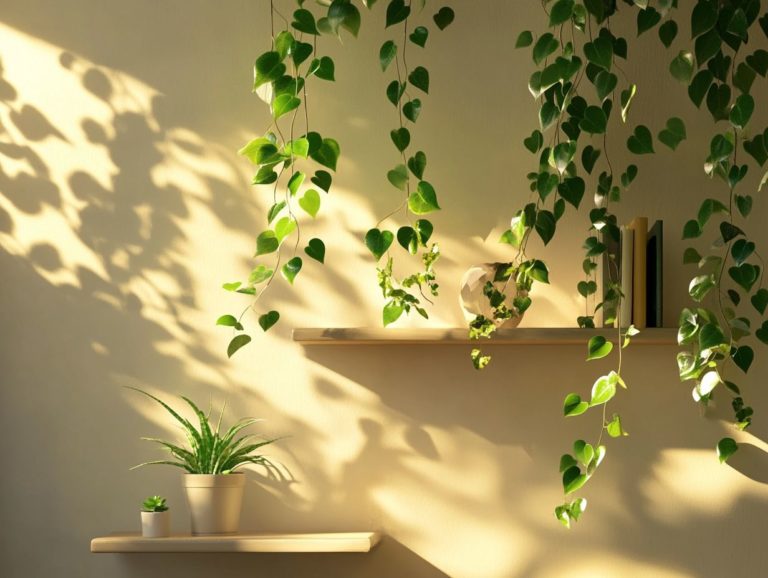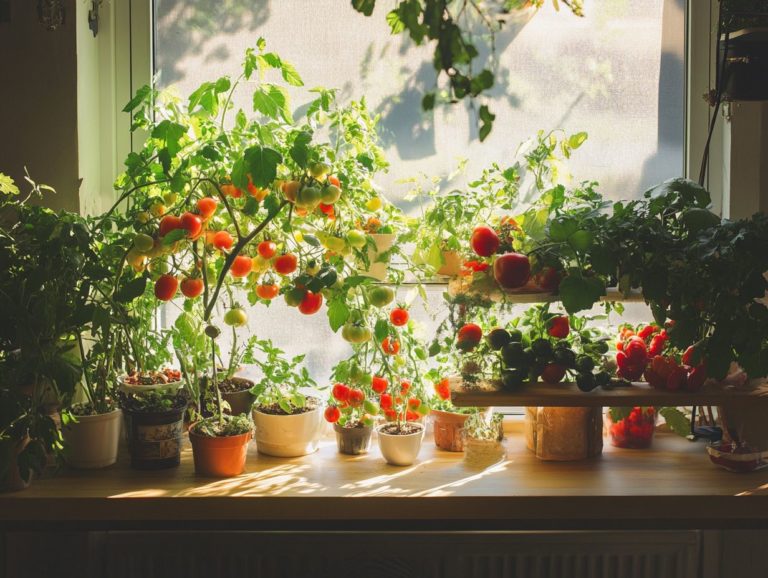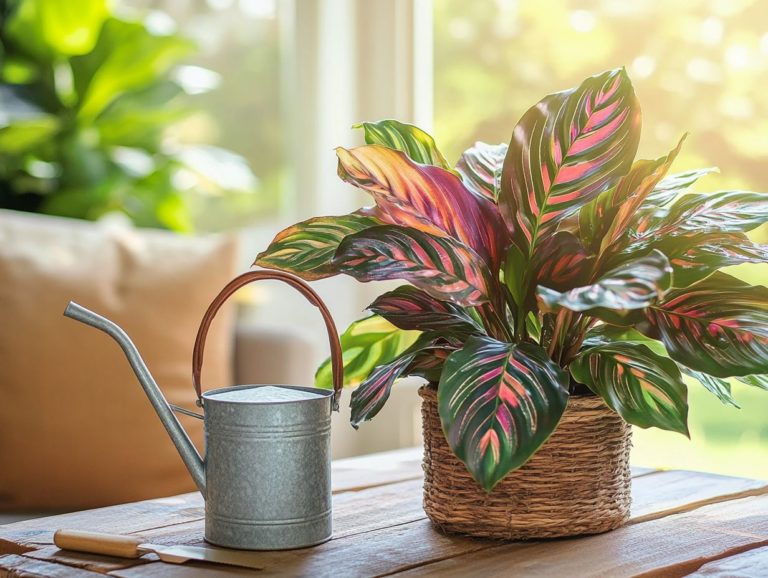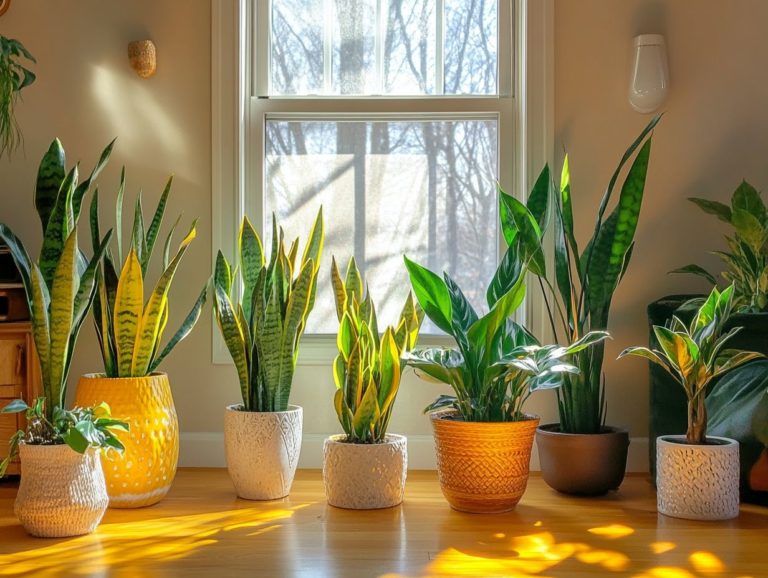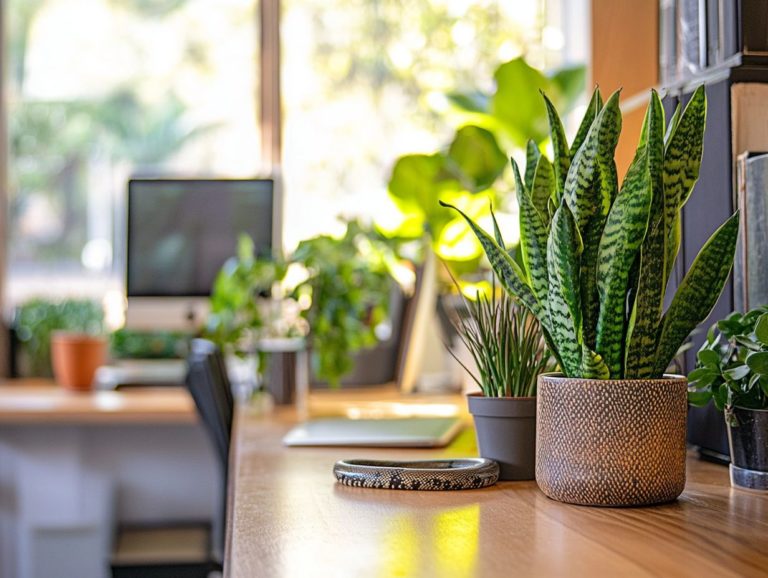5 Best Indoor Plants for Air Quality
Indoor plants are more than just a splash of greenery they can transform your home into a breath of fresh air! They serve as essential allies in enhancing the air quality of your home, contributing significantly to natural air purification.
This article delves into five of the finest indoor plants such as the Snake Plant and Peace Lily that not only elevate your space aesthetically but also improve air quality through their remarkable purifying abilities. You ll find insights into their unique benefits, the common indoor air pollutants they help combat, essential care tips, and guidance on selecting the best plants for your living environment.
Uncover how these verdant companions can truly transform your home into a cleaner air sanctuary!
Contents
- Key Takeaways:
- 1. Snake Plant
- 2. Peace Lily
- 3. Spider Plant
- 4. Aloe Vera
- 5. English Ivy
- What Are the Benefits of Having Indoor Plants?
- How Do Indoor Plants Help Improve Air Quality?
- What Are the Common Indoor Air Pollutants and How Do Plants Help Remove Them?
- What Are Other Benefits of Having These Plants in Your Home?
- How Can One Take Care of These Indoor Plants?
- What Are Some Tips for Choosing the Right Indoor Plants for Air Quality?
- Frequently Asked Questions
Key Takeaways:
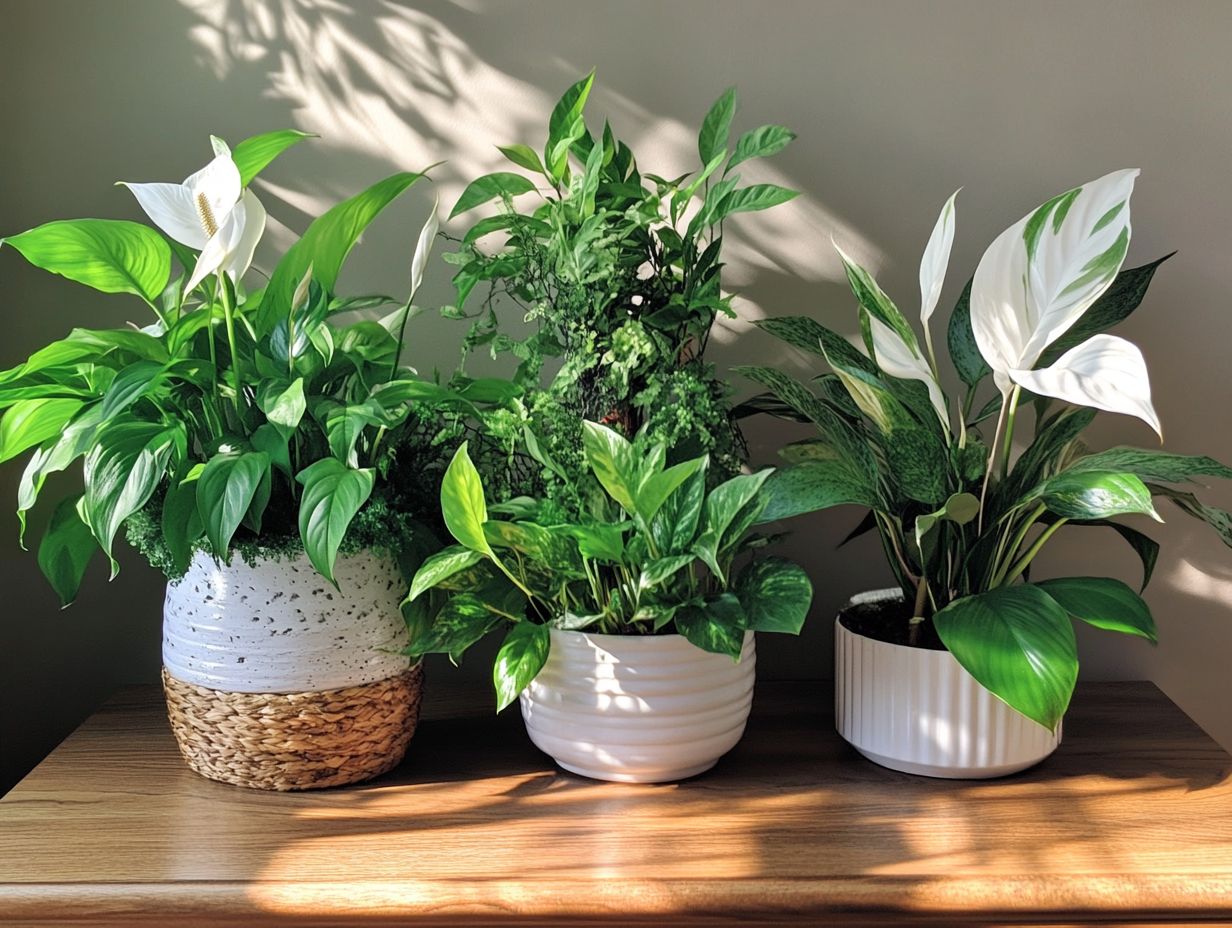
- Snake plants, peace lilies, spider plants, aloe vera, and English ivy are the top 5 plants for improving air quality indoors.
- Indoor plants help to remove common air pollutants, such as formaldehyde, benzene, and carbon monoxide, while also increasing oxygen levels in the air.
- Besides improving air quality, indoor plants have been shown to reduce stress, increase productivity, and enhance overall well-being.
1. Snake Plant
The Snake Plant, also known as Sansevieria, stands out as a remarkable indoor plant, revered for its striking architectural foliage and impressive air-purifying capabilities. It s an excellent choice for enhancing your home s air quality while simultaneously elevating its aesthetic appeal.
This hardy species thrives effortlessly in low-light conditions. Its unique ability to convert CO2 into oxygen at night sets it apart from many houseplants, which typically perform this task only during the day.
Beyond its visual charm, the Snake Plant actively filters out harmful Volatile Organic Compounds (VOCs) like formaldehyde and benzene. With its minimal watering needs and resilience to occasional neglect, this plant caters to both seasoned botanists and beginners alike.
2. Peace Lily
The Peace Lily, with its elegant white blooms and lush green leaves, is not just a stunning addition to your indoor space; it s also an exceptional air-purifying plant that efficiently removes various toxins from your environment.
This plant thrives in low to moderate light, making it the perfect choice for dimly lit rooms or office spaces. With minimal effort required, all it needs is regular watering and the occasional dusting of its leaves to maintain its health and beauty.
Besides enhancing your d cor, the Peace Lily plays a vital role in regulating humidity levels, contributing to a more comfortable living atmosphere. Its remarkable air purification capabilities filter out pollutants like formaldehyde and benzene, promoting overall well-being through its calming presence.
3. Spider Plant
The Spider Plant, with its gracefully arching green leaves and delicate white flowers, has become a favored choice for indoor gardeners. Its low maintenance needs and outstanding air-purifying abilities make it a quintessential addition to any home striving for cleaner air.
This resilient houseplant thrives in various conditions, adapting seamlessly to both bright light and partial shade. It requires minimal watering and reproduces through its charming offshoots, affectionately known as ‘pups’.
Not only does the Spider Plant enhance your indoor environment by effectively eliminating toxins such as formaldehyde and benzene, but it also serves as an ally in the quest for a pollution-free home.
Choose your indoor plants today, and check out the top 5 indoor plants for east-facing windows to breathe easier!
4. Aloe Vera

Aloe Vera, known for its impressive medicinal properties, is not just an attractive succulent. It thrives indoors, offering aesthetic charm and a host of health benefits, such as air purification and soothing various skin conditions with its gel-like sap.
This resilient plant is remarkably low-maintenance, making it a perfect choice for both novice gardeners and those with hectic lifestyles. Preferentially basking in bright, indirect sunlight, it flourishes in well-draining soil and can handle occasional neglect, like infrequent watering.
What s truly remarkable about Aloe Vera is its ability to enhance indoor air quality, effectively filtering out toxins and elevating your overall environment. Its rich history in traditional medicine underscores its roles in promoting wound healing and aiding digestion. This is why many people regard it as a staple in natural health remedies and a key element in enhancing air quality at home.
5. English Ivy
English Ivy is a remarkable climbing plant known for its lush green foliage. It also plays a vital role in improving air quality by absorbing common indoor pollutants and contributing to humidity regulation.
Not only does it elevate the aesthetic of your space, but it also promotes a cleaner air environment. This plant is great at removing harmful substances like formaldehyde and benzene, making it an outstanding addition to any indoor setting.
English Ivy thrives under a range of conditions, from bright indirect light to partial shade, allowing it to adapt seamlessly in both cozy apartments and spacious offices. Caring for it is incredibly easy! Regular watering and occasional pruning are all it takes to keep it healthy and vibrant, ensuring its continued effectiveness as a natural air purification system.
With its resilience and low maintenance needs, it’s no wonder English Ivy has captured the hearts of plant enthusiasts who value both its beauty and functional benefits in promoting a pollution-free home.
What Are the Benefits of Having Indoor Plants?
Having indoor plants offers you many benefits, including improved air quality and a natural air cleaning system. They not only enhance air quality through natural purification but also elevate the aesthetic appeal of your home decor while contributing to humidity regulation. This makes your living environment both healthier and more inviting.
These green companions work diligently to filter out harmful pollutants, significantly improving the air quality around you. Take, for instance, the Snake Plant, Peace Lily, and Spider Plant; these species are celebrated for their incredible air-purifying abilities. If you’re interested in enhancing your space, check out the top 5 indoor plants for bright spaces, which effectively eliminate toxins like benzene, formaldehyde, and trichloroethylene (a common indoor chemical).
Engaging with indoor plants has been linked to improved psychological well-being, offering numerous advantages beyond just aesthetics. They help reduce stress levels and elevate your mood, as their soothing presence brings a touch of nature indoors, fostering a calm and tranquil environment.
By incorporating these plants into your daily life, you not only brighten your indoor spaces but also nurture a healthier and more serene living experience. If you’re looking for options, check out the 5 best indoor plants for beginners to propagate. So, why not bring some greenery into your home today?
How Do Indoor Plants Help Improve Air Quality?
Indoor plants are vital for improving air quality. They effectively remove harmful chemicals through natural purification processes, a phenomenon well-documented in research, including NASA’s Clean Air Survey, which highlights their importance in biological life support.
NASA’s studies reveal that common household plants like the peace lily, spider plant, and snake plant possess remarkable abilities to filter out harmful substances such as benzene, formaldehyde, and xylene. These plants absorb toxins through their leaves and roots, where beneficial microorganisms break down these impurities, resulting in a healthier indoor environment. If you’re looking for more options, consider adding some of the top 5 shade-tolerant indoor plants to your collection. Not only do they improve air quality, but they also elevate the aesthetic appeal of your space.
The synergy between plant foliage and air circulation can lead to a significant reduction in respiratory irritants. This creates a calming and revitalizing atmosphere in your home that enhances overall well-being. For those looking to improve their indoor greenery, consider exploring 5 ways to promote healthy indoor plants.
What Are the Common Indoor Air Pollutants and How Do Plants Help Remove Them?
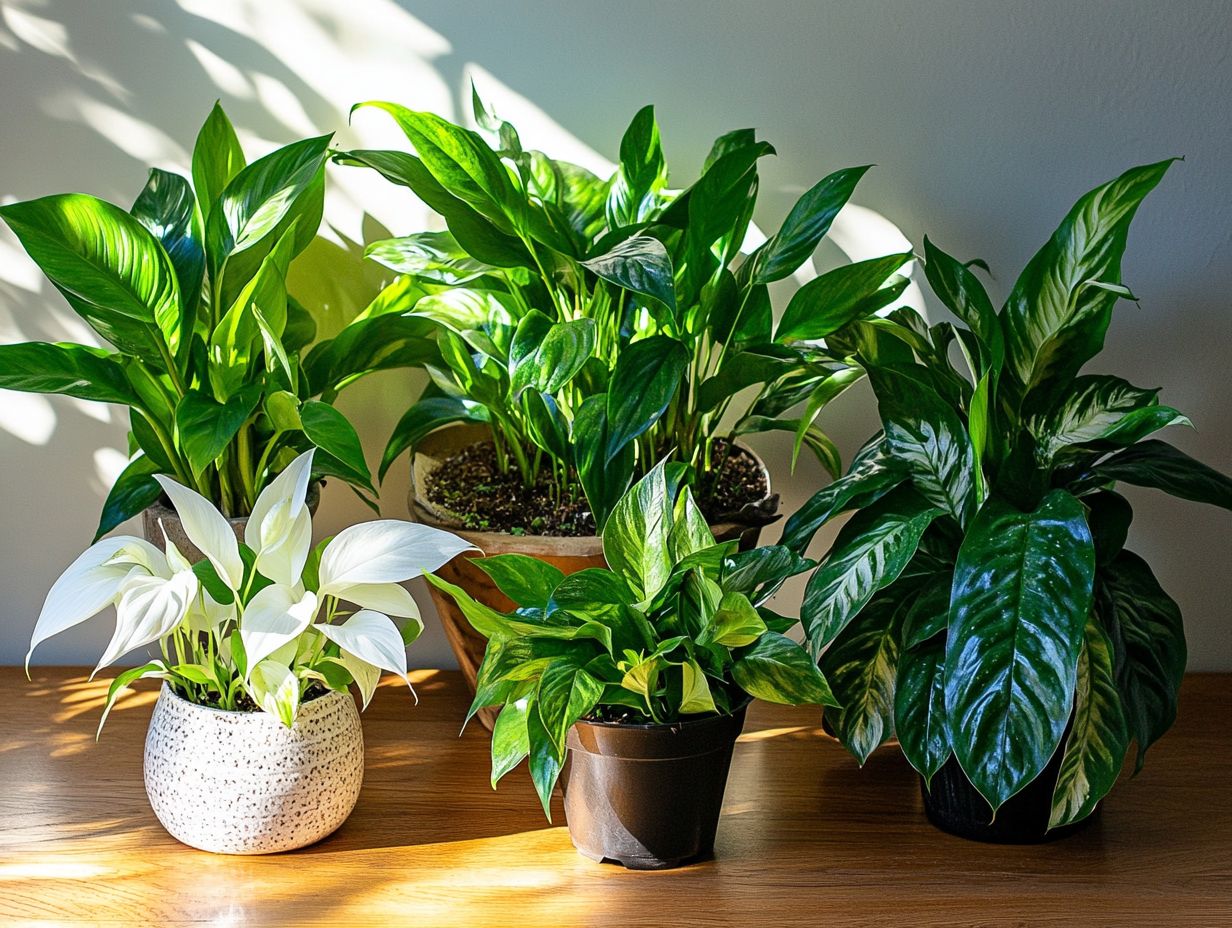
Common indoor air pollutants like formaldehyde and benzene can harm your health. Introducing indoor plants such as the Rubber Plant, Boston Fern, and Golden Pothos helps eliminate these toxins from the air, creating a healthier living space and promoting environmental protection.
These pollutants often emerge from everyday household items think cleaning agents, paints, and synthetic furniture contributing to poor indoor air quality. By incorporating specific plant species into your home, you’re not just enhancing aesthetics; you’re also playing a pivotal role in air purification. For example, the Peace Lily is well-known for absorbing harmful chemicals, while the Spider Plant excels at eliminating carbon monoxide. Additionally, consider 5 indoor plants that thrive in clay soil to improve your indoor environment.
Act now! Welcome these natural air purifiers into your environment to dramatically enhance your indoor air quality, promoting both mental well-being and physical health. Discover the top 10 indoor plants for artificial light to foster a vibrant and invigorating atmosphere in your home filled with the benefits of houseplant care.
What Are Other Benefits of Having These Plants in Your Home?
Indoor plants offer health benefits that go beyond aesthetics. They reduce stress, boost concentration, and uplift your mood, all while helping to regulate humidity levels, which is crucial for maintaining a comfortable indoor environment.
These green companions create an inviting atmosphere, contributing to cleaner air quality through effective plant selection. Research shows that interacting with indoor greenery can significantly decrease anxiety and depression, fostering a sense of calm and tranquility.
The presence of plants can even spark creativity and improve productivity, especially in a home office. The natural moisture released through their transpiration helps maintain comfortable humidity levels, supporting respiratory health and overall comfort.
By integrating indoor plants into your living spaces, you’re not just beautifying your environment you re investing in profound benefits for both your mental and physical wellness, essential for a balanced lifestyle.
How Can One Take Care of These Indoor Plants?
Caring for indoor plants involves understanding their unique needs, such as the right lighting and humidity levels for optimal growth, water and light requirements for optimal plant health, and humidity levels. This knowledge enables you, even as a novice gardener, to keep your houseplants healthy and flourishing with ease.
For example, succulents, snake plants, English Ivy, and Peace Lily are among the best indoor plants for air purification. They are fantastic low-maintenance options that cater to those embarking on indoor gardening adventures. Additionally, if you’re looking for best indoor plants for bright light, these resilient plants can handle lower humidity and inconsistent watering, forgiving those occasional slip-ups along the way.
On the other hand, more temperamental plants like ferns, including the Boston Fern, are great for humidity-loving enthusiasts. Certain tropical varieties like the Areca Palm thrive in consistently high humidity and bright, indirect light. It’s vital to recognize the signs of too much water, which can lead to root rot and other problems, or inadequate light since these common pitfalls can cause stress or, sadly, the demise of your green friends.
With some knowledge and mindful attention, you can confidently navigate the essentials and enjoy the many rewards of nurturing your indoor foliage, which also provides natural air-cleaning systems and includes the best indoor plants for pest control.
What Are Some Tips for Choosing the Right Indoor Plants for Air Quality?
Choosing the right indoor plants for air quality can truly elevate your living space. To achieve optimal results, consider essential factors like light availability, environmental factors affecting plant growth, maintenance requirements for easy care, and each plant’s specific air-purifying abilities.
As you embark on your green journey, remember that not all plants will flourish in every indoor environment. Some species excel at filtering out common toxins, including formaldehyde and benzene, while others are more forgiving of low light and varying humidity levels. To maintain their health, consider following the 5 best practices for indoor plant hygiene, suited for plants like the ZZ Plant.
Take a moment to assess how much time you can commit to plant care; this will guide your selections. Indoor gardening is rewarding and fun, especially with resilient and low-maintenance varieties such as:
- Snake plants
- Peace lilies
- Pothos
Remember, successful indoor gardening relies on matching the plants’ needs with your living space.
Frequently Asked Questions
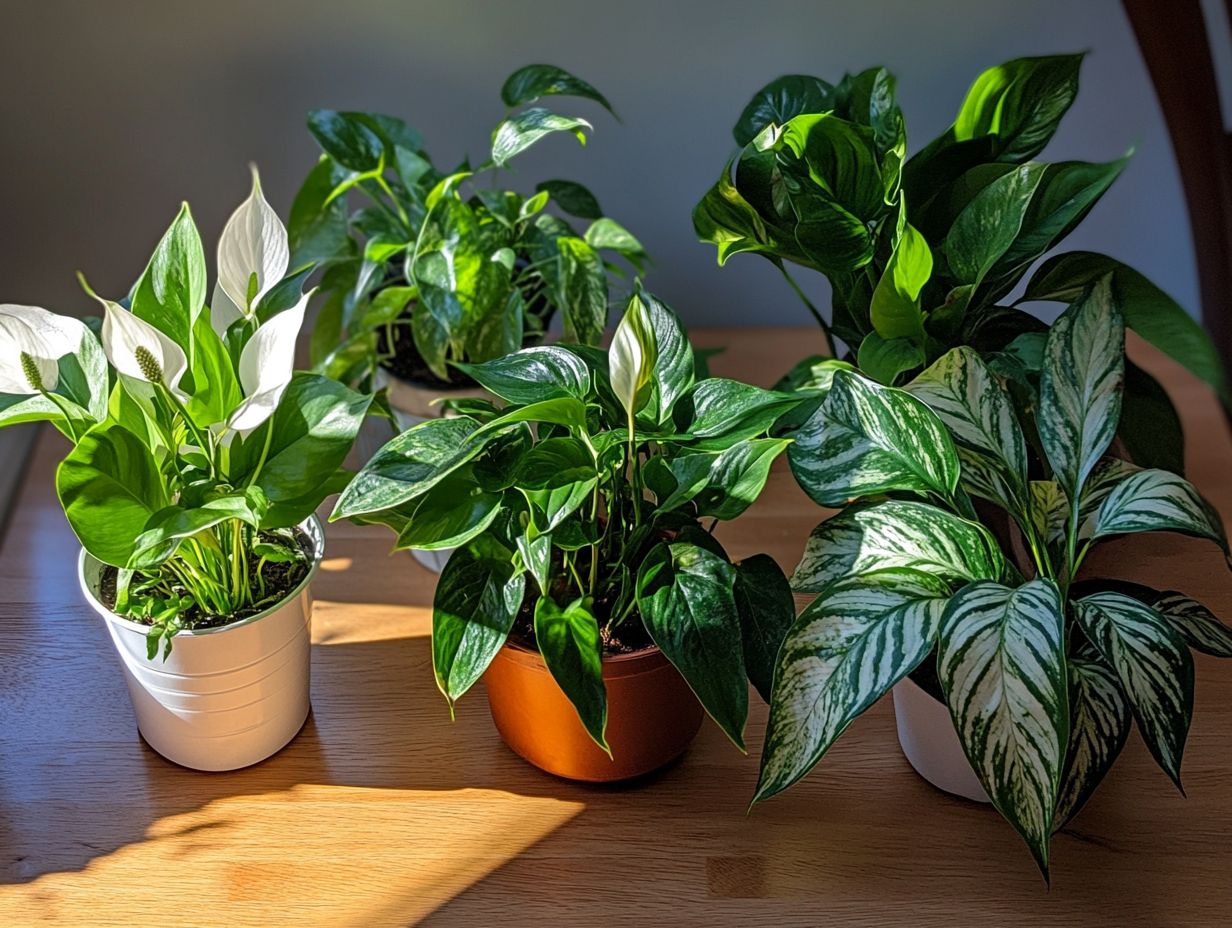
What are the 5 best indoor plants for air quality?
The 5 best indoor plants for air quality are the Peace Lily, Snake Plant, English Ivy, Bamboo Palm, and Spider Plant.
How do these plants improve indoor air quality?
These plants are known for their ability to filter and purify the air by removing toxins such as formaldehyde, benzene, and xylene.
Which plant is best for removing formaldehyde?
The Peace Lily is the best plant for removing formaldehyde from the air. It is one of the most efficient air purifiers and complements the natural abilities of houseplants.
What benefits do these plants provide besides improving air quality?
In addition to improving air quality, these plants also add moisture to the air, reduce stress and anxiety, and can even boost mood and productivity.
How do I take care of these indoor plants?
These plants require minimal maintenance and can thrive in low light conditions. They should be watered regularly and placed in well-draining pots with proper drainage. It is also important to periodically wipe their leaves to remove dust and other pollutants.
Are these plants safe to have around pets?
While these plants are not toxic, they can cause stomach upset if ingested by pets. It is best to keep them out of reach of curious pets or opt for pet-friendly alternatives like the Boston Fern.

